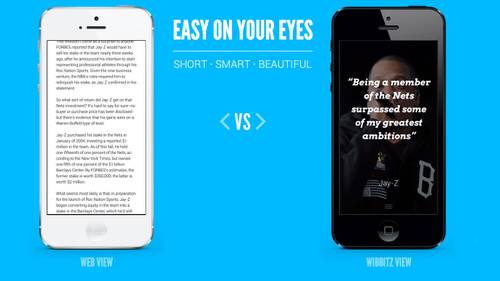
Israeli startup Wibbitz doesn’t want you to read the news. It wants to read the news to you, in the form of 1-2 minute video summaries narrated by a helpful synthetic voice and accompanied by video of related images and animated infographics.
Wibbitz made a splash last summer when it raised $2.3 million for its video news-summary app, and now it’s launched that app on iOS. The Wibbitz technology converts news articles and blog posts into video designed to play on smartphones in an effort to deliver information in a way that bypasses reading limitations like screen size and user location.
(Read more: The Race To Replace Google Reader)
The Wibbitz app is free and requires no login. And what it provides is a rather strange – yet surprisingly effective – alternative to, well, news reading. For bemused publishers who might be inclined to view Wibbitz as yet another article-scraping aggregator enemy, the app also offers another possible channel for putting their stories out in front of a wide audience.
Whether any of this is good or bad depends in part on what you think about automated news delivery.
Wibbitz Is A Cool Idea, And It Works
So what the heck is automated video news delivery, anyway? For Wibbitz, it means using summation algorithms – similar to those employed by the late Summly news app, since acquired by Yahoo – and natural language technology that evokes the audio aesthetics of Apple’s Siri. All that comes together to turn article text into video of moving pictures overlaid with headlines and keywords, all narrated by your friendly neighborhood automaton.
Luckily, Wibbitz’s automated speech has improved significantly since last year and is now far less robotic than Siri, most noticeably because it doesn’t appear to run into as many pronunciation hiccups as the Apple assistant. The Wibbitz voice also changes vocal tones depending on whether you’re listening to headlines or the actual summaries, which is nice touch that helps alleviate the tedium of listening to dull, flat speaking tones for any period of time.
Currently, the app is limited to summarizing Reuters news stories, although those articles cover world and international news, business, sports, tech and entertainment. Other publishers have been experimenting with Wibbitz integration on their sites since last year, a process that’s as simple as dumping in a line of JavaScript code to generate a video for a particular story that can then be shared across social networks.
What Wibbitz Does Well
Wibbitz manages to effectively combine the convenience of radio and television delivery with back-end AI technology and interactive HTML5 information delivery – the sort of thing we’re getting more used to with smartphone apps like the news reader Circa. This kind of delivery is both faster than skimming stories on Facebook or Flipboard and more productive and engaging than getting your news from tweeted headlines.
The app also employs some clever design. After clicking into a section like top news or business, it will automatically begin cycling through the carousel of stories it pulls from Reuters’ RSS feed by reading you each headline. If you’re interested in the full summary, you swipe up to enter into the moving picture experience. (Swiping down takes you in the opposite direction.)
A second swipe up brings you to the full text of the original article. But if Wibbitz succeeds in parsing out the critical information you need and presenting it in a visually effective fashion – something it does well, at least in my experience – then calling up the original article is rarely necessary.
Moving From Mobile
The Wibbitz app is only part of what the startup is about. Wibbitz also aims to strike partnerships with publishers to help them easily create videos with the company’s simple code and then to disseminate them.
In the coming months, Wibbitz plans to release its technology as an embeddable service on third-party apps, CEO and co-founder Zohar Dayan told TechCrunch. One of the first in line to use this is reportedly the UK daily The Telegraph. Dayan also sees television, specifically the smart TV, as a potential customer for his company’s technology.
All of which means that the video news summary could proliferate in unexpected ways in coming months. And that’s a smart strategy for Wibbitz. While its iOS app is certainly cool at first sight, the experience of having information dictated to you via AI may simply be too strange for many people to deal with until they get more used to it.









